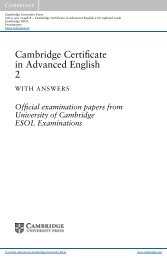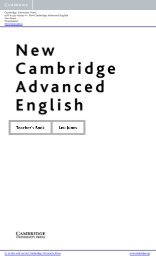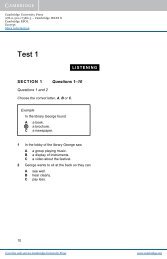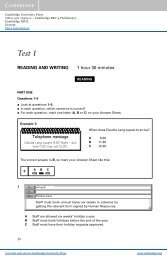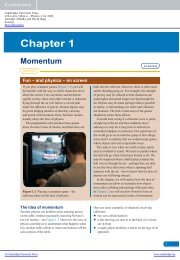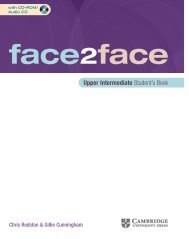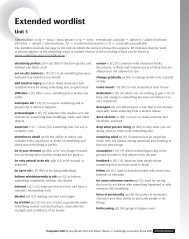Skills for Study Level 2 Teacher's Book - Cambridge University Press
Skills for Study Level 2 Teacher's Book - Cambridge University Press
Skills for Study Level 2 Teacher's Book - Cambridge University Press
Create successful ePaper yourself
Turn your PDF publications into a flip-book with our unique Google optimized e-Paper software.
2bSuggested answers1 The speaker’s reference to the table2 The summary of the main findings3 The speaker’s commentary on what the findings representSo, we gathered fifteen images of different rooms from a variety of differentsources. They were all work spaces, to an extent, but laid out in different ways,and, 1 as you can see from the table here, we had them grouped into fourmain categories: ‘modern’; ‘traditional’; ‘peaceful’ and ‘energetic’ – dependingon the type of decorations and furniture and so on – I’ve got the images hereif you want to have a look at them in a moment. 2 So, what does this tell usabout the ratings? What we see, of course, is that most of the answerstend to cluster around the middle of the scale, which was to be expected.However, an interesting point, I think, is that people seemed to rate the more‘conventional’ rooms as being better <strong>for</strong> creativity – the ones with a standardmodern or traditional look. They both had higher ratings at the top end of thescale than the energetic and peaceful rooms, which were the ones with moreovertly ‘creative’ features like potted plants and unconventional furnishingsand decorations. 1 If you notice here on Table 1, 2 if we combine the stronglypositive ratings of 4 and 5, we get scores of around 100 <strong>for</strong> the traditionaland modern rooms, but only around 72 <strong>for</strong> the peaceful and energeticrooms. That’s reversed if we look at the bottom end of the scale: combiningratings 1 and 2, we find that significantly more people rate the energetic andpeaceful rooms as being poor <strong>for</strong> creativity compared to the traditional andmodern ones. 3 Now of course this was quite a limited study, and there area number of possible reasons why this may be so, but the fact that we alsohave more people giving lower scores to these two unconventional roomssuggests something interesting that’s going on. One possibility is that peopletend to feel more creative, or give a higher rating, to the rooms that they’remore com<strong>for</strong>table in – more familiar with, if you like.2c Students check their answers with a partner.2dSuggested answersPeople tend to base their judgements of whether a room is suitable <strong>for</strong>creative thinking on furnishings and lighting, and to a lesser extent thepresence of plants.2eAnswers4.5Number or titleof graphicFindingsSpeaker’scommentsPresentation 1 Presentation 2Figure 1‘High’ rating <strong>for</strong> creativity:natural furnishings suchas wood; lighting type‘Low’ rating <strong>for</strong> creativity:colour scheme; syntheticfurnishingsPeople associate naturalelements with creativity.Not given‘High’ rating <strong>for</strong> creativity:lighting; natural furnishings‘Low’ rating <strong>for</strong> creativity:plants; bright colour schemesand synthetic furnishingsPeople prefer natural things.Unit 4 Part D ∙ Reporting in speech 125



